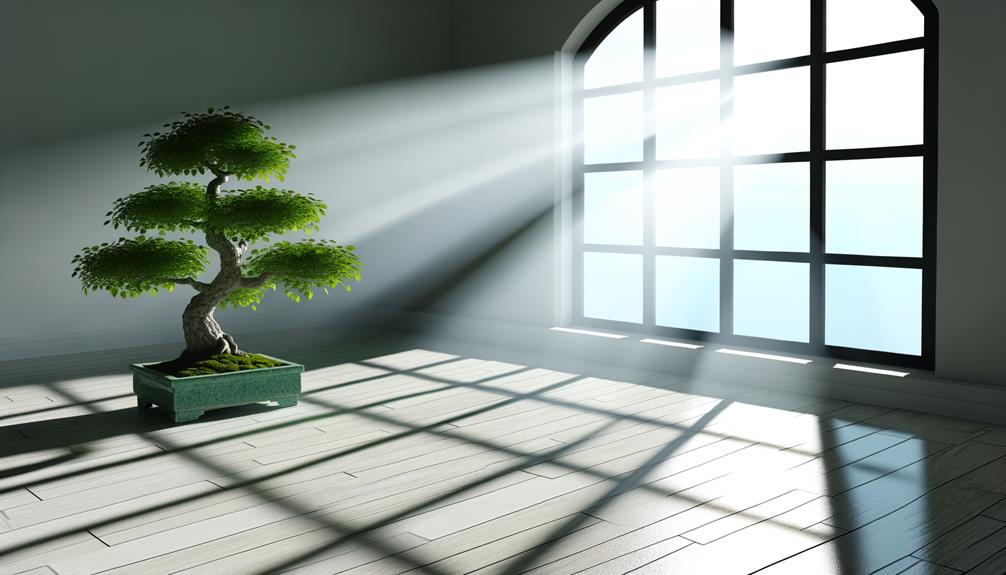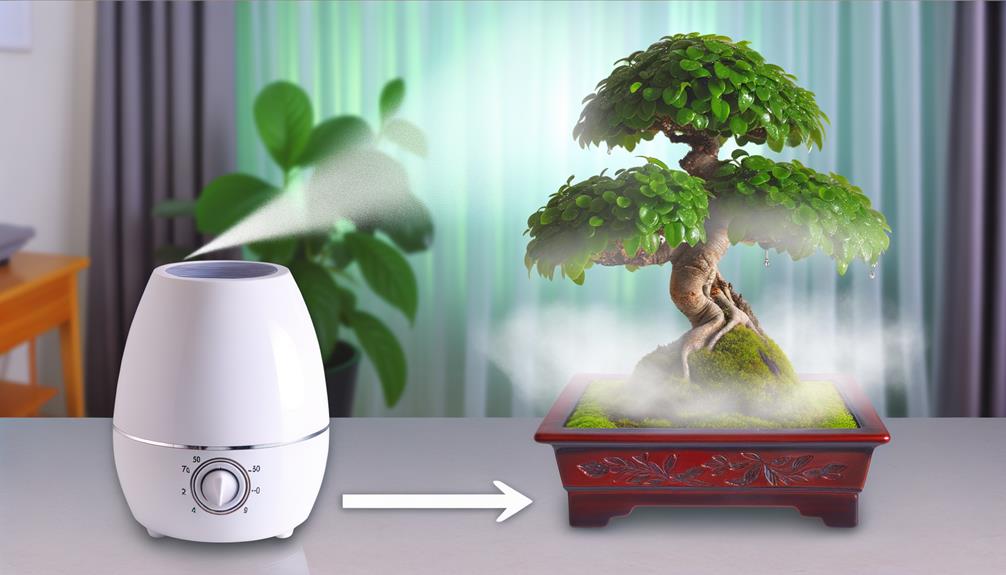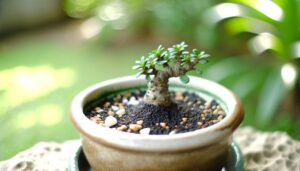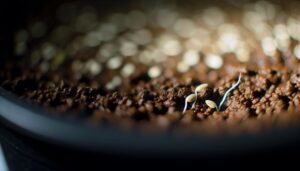5 Essential Tips for Growing Bonsai Indoors Successfully
Yes, bonsai can be grown indoors with adherence to essential horticultural principles. Key factors include maintaining proper light, controlling humidity, and using well-draining soil.
Suitable species like Ficus and Jade thrive with consistent temperature and balanced N-P-K fertilization. Pruning and wiring are integral for aesthetic form and structural health.
Pest and disease management require vigilant monitoring and timely intervention. Seasonal adjustments in watering, lighting, and fertilization promote optimal growth.
Proper container selection, emphasizing adequate drainage, enhances plant health. Avoid common pitfalls such as inadequate light or overwatering.
Continue for an in-depth understanding of enhancing indoor bonsai cultivation.

Key Takeaways
- Indoor bonsai require sufficient light, ideally near a south-facing window or under grow lights.
- Maintaining proper humidity levels and regular misting is essential for indoor bonsai health.
- Specific bonsai species, such as Ficus and Jade, are more suited for indoor cultivation.
- Using well-draining soil with balanced fertilization ensures optimal growth conditions.
- Regular pruning and shaping are necessary to maintain the desired form and health indoors.
Indoor Bonsai Basics

Cultivating bonsai indoors demands a thorough comprehension of horticultural principles. This includes appropriate lighting, humidity control, and soil composition. Adequate lighting is crucial. Bonsai trees need a spectrum of light that imitates natural sunlight. This is often achieved through full-spectrum fluorescent or LED grow lights.
Humidity control is crucial because indoor environments typically have lower humidity levels. The use of humidity trays or frequent misting can help maintain ideal levels. Soil composition must ensure proper aeration and drainage. A well-balanced mix often includes akadama, pumice, and lava rock.
Additionally, bonsai trees require regular watering. However, over-watering must be avoided to prevent root rot. These factors collectively create a microenvironment conducive to the healthy growth of indoor bonsai.
Suitable Bonsai Species
Selecting appropriate species is fundamental to the success of indoor bonsai cultivation, as some tree varieties are better adapted to indoor conditions and can thrive in a controlled environment with proper care. The following species are particularly suitable for indoor growth due to their adaptability and resilience:
- Ficus (Ficus retusa, Ficus benjamina): Known for their robust nature, Ficus species exhibit high tolerance to low humidity and variable light conditions.
- Jade Plant (Crassula ovata): This succulent species is well-suited for indoor environments, requiring minimal watering and thriving in moderate light.
- Chinese Elm (Ulmus parvifolia): Exhibits strong resistance to indoor conditions, including fluctuating temperatures and lower light levels, making it an ideal candidate.
These species offer a solid foundation for successful indoor bonsai cultivation.
Light Requirements

Understanding the light requirements for indoor bonsai is essential for best growth and development. This involves evaluating natural light sources, integrating artificial lighting options, and making seasonal light adjustments to simulate the natural photoperiod.
Each aspect plays a significant role in ensuring that the bonsai receives adequate photosynthetically active radiation (PAR) throughout the year.
Natural Light Sources
Adequate natural light is essential for the best growth and health of indoor bonsai, necessitating placement near windows with sufficient exposure to direct sunlight. The photosynthetic needs of bonsai require a minimum of six hours of direct sunlight daily.
Ideal positioning involves:
- South-Facing Windows: These provide the most consistent and intense light throughout the day, important for photosynthesis.
- East-Facing Windows: Suitable for receiving morning light, which is less intense but can still promote healthy growth.
- West-Facing Windows: These capture afternoon sunlight, beneficial for species that thrive under slightly warmer conditions.
Inadequate natural light will lead to etiolation, where the bonsai exhibits elongated, weak stems, and pale leaves, undermining its aesthetic and physiological integrity.
Artificial Lighting Options
To meet the specific light requirements of indoor bonsai, especially in conditions where natural light is insufficient, the implementation of artificial lighting systems becomes essential. Artificial light sources such as LED grow lights, fluorescent lamps, and high-intensity discharge (HID) lamps provide the necessary photosynthetically active radiation (PAR) spectrum. These lighting systems can be optimized to deliver consistent light intensity and duration, closely mimicking natural sunlight. Below is a table summarizing key artificial lighting options for indoor bonsai cultivation:
| Lighting Type | Key Features |
|---|---|
| LED Grow Lights | Energy-efficient, customizable spectrum |
| Fluorescent Lamps | Affordable, broad-spectrum light |
| HID Lamps | High intensity, suitable for larger setups |
| Incandescent Bulbs | Low cost, less efficient |
| Compact Fluorescent Lights (CFLs) | Moderate efficiency, easy setup |
Understanding the properties of these lighting options is essential for successful indoor bonsai cultivation.
Seasonal Light Adjustments
Seasonal photoperiod adjustments are essential for maintaining the physiological health and growth cycles of indoor bonsai trees. These adjustments mimic natural changes in day length, vital for processes such as dormancy, budding, and leaf drop.
To effectively manage indoor bonsai light requirements, consider the following:
- Winter Months: Provide 10-12 hours of light per day to simulate shorter daylight periods, promoting dormancy.
- Spring and Summer: Increase light exposure to 14-16 hours daily, facilitating active growth and photosynthesis.
- Autumn: Gradually reduce light to 12-14 hours, preparing the bonsai for dormancy.
Using programmable timers and supplemental LED grow lights can aid in achieving these photoperiod adjustments, ensuring robust and healthy bonsai development.
Temperature Control
Maintaining ideal temperature ranges is pivotal for the health and growth of indoor bonsai trees. Fluctuations can greatly impact their physiological processes. Best temperature control involves maintaining a consistent range between 60°F to 75°F (15°C to 24°C).
Drastic temperature shifts can lead to thermal stress, adversely affecting photosynthesis, transpiration, and metabolic activities. It is necessary to avoid placing bonsai near heating vents or drafty windows, as these can cause unpredictable temperature variations.
Utilizing a digital thermostat can provide precise monitoring, ensuring stable conditions. Additionally, some species may enter dormancy if exposed to temperatures below their tolerance threshold, hindering growth and vitality.
Therefore, meticulous temperature regulation is key for sustaining the delicate equilibrium necessary for indoor bonsai vitality.
Humidity Levels

Maintaining appropriate humidity levels is important for the health and development of indoor bonsai trees, as it directly impacts their transpiration rates and overall physiological processes.
The ideal humidity range for most bonsai species is usually between 40% and 60%, allowing for best moisture absorption and retention in the substrate.
To achieve and sustain these conditions, various methods such as humidity trays, misting, or the use of humidifiers may be employed, ensuring consistent moisture levels in the microenvironment.
Ideal Humidity Range
The perfect moisture level range for growing bonsai indoors typically falls between 40% to 60%, guaranteeing best transpiration and nutrient absorption. This range facilitates ideal stomatal function, essential for gas exchange and water regulation. Inadequate moisture can lead to cellular dehydration and impaired photosynthesis.
To maintain an ideal environment, consider the following:
- Moisture Trays: Utilize shallow trays filled with water and pebbles placed beneath the bonsai pot to increase localized moisture through evaporation.
- Misting: Regularly mist the foliage to simulate natural dew and maintain surface moisture levels.
- Humidifiers: Deploy ultrasonic or evaporative humidifiers to stabilize ambient moisture, especially in arid climates or during winter heating.
These practices ensure a stable microclimate, promoting the health and longevity of indoor bonsai.
Maintaining Moisture Levels
Ensuring ideal moisture levels is important for the physiological well-being of indoor bonsai, as it directly affects their transpiration rate, nutrient uptake, and overall metabolic processes.
To maintain best moisture levels, it is essential to employ methods such as misting the foliage with deionized water, utilizing moisture trays, and integrating room humidifiers.
The relative moisture should ideally be maintained between 40-60%, as deviations can lead to stress responses including stomatal closure, impaired photosynthesis, and reduced growth.
Additionally, monitoring ambient temperature and air circulation is vital, as these factors influence evaporative demand and moisture retention.
Regularly evaluating soil moisture content and ensuring proper drainage are also essential to prevent root rot and other moisture-related pathologies.
Watering Techniques
Effective watering techniques are essential for the best growth and health of indoor bonsai trees, requiring precise attention to soil moisture levels and drainage conditions. Ensuring ideal hydration involves several key practices, each grounded in botanical principles and horticultural expertise:
- Soil Moisture Monitoring: Utilize a soil moisture meter to detect accurate water content, ensuring hydration without over-saturation.
- Consistent Watering Schedule: Establish and adhere to a regular watering routine, recognizing that frequency may vary with seasonal changes and indoor climate factors.
- Proper Water Application: Employ a fine mist sprayer or watering can with a narrow spout to evenly distribute water, preventing root damage and promoting uniform soil moisture.
These techniques collectively support the physiological requirements of indoor bonsai, fostering robust growth and health.
Soil and Fertilizer

Selecting the appropriate soil composition and fertilizer regimen is crucial for maximizing nutrient availability and promoting the vigorous growth of indoor bonsai trees. A well-draining soil mix, typically composed of Akadama, pumice, and lava rock, ensures sufficient aeration and moisture retention. The following table illustrates an ideal soil mix ratio:
| Component | Proportion |
|---|---|
| Akadama | 50% |
| Pumice | 25% |
| Lava Rock | 25% |
Fertilization requires a balanced nutrient profile, incorporating nitrogen (N), phosphorus (P), and potassium (K) in a 10-10-10 NPK ratio. During the growing season, applying a liquid fertilizer bi-weekly supports strong foliar and root development. In the dormant period, a reduced application frequency is advisable to avoid nutrient burn.
Pruning and Shaping
After establishing a robust foundation with the proper soil and fertilizer regimen, attention must be directed towards the meticulous practices of pruning and shaping to achieve the desired aesthetic and structural integrity of indoor bonsai trees.
Pruning involves the selective removal of branches, leaves, and roots to control growth patterns, encourage ramification, and maintain proportion. Shaping employs techniques such as wiring and clamping to guide the orientation of branches and trunk.
Key steps include:
- Structural Pruning: Remove large branches to form the primary structure.
- Maintenance Pruning: Trim smaller branches and leaves to refine shape.
- Wiring: Apply wire to branches to direct growth and establish form.
These practices are pivotal to cultivating bonsai that exemplify both artistry and horticultural excellence.
Pest and Disease Management

Effective pest and disease management is critical for maintaining the health and aesthetics of indoor bonsai. Common indoor pests such as aphids, spider mites, and scale insects can cause significant damage, necessitating rigorous monitoring and timely intervention.
Disease prevention strategies, including proper sanitation, humidity control, and the use of fungicidal treatments, alongside appropriate treatment methods, are essential to mitigate the adverse effects on bonsai plants.
Common Indoor Pests
Indoor bonsai trees are frequently susceptible to a variety of pests, including spider mites, aphids, and scale insects, which can compromise their health and vigor. These arthropods can induce chlorosis, impede photosynthesis, and even cause defoliation. Effective pest management necessitates early detection and identification.
- Spider Mites: These arachnids feed on cellular fluids, causing stippling and bronzing of foliage. Regular inspection with a magnifying glass is recommended for early intervention.
- Aphids: These hemipterans excrete honeydew, fostering sooty mold growth. Systemic insecticides may be employed for thorough eradication.
- Scale Insects: These pests attach to stems and leaves, forming protective shells. Horticultural oils can be used to suffocate them.
Early intervention is essential to maintain bonsai health.
Disease Prevention Tips
Maintaining ideal conditions and implementing proactive measures can greatly mitigate the incidence of diseases in indoor bonsai trees, ensuring their sustained health and longevity. Best humidity levels, typically around 40-60%, prevent fungal growth. Adequate air circulation is essential to reduce the risk of pathogenic infestations.
Regularly inspect foliage for early signs of disease, such as chlorosis, necrosis, or atypical growth patterns. Implementing a consistent watering regimen, avoiding waterlogging, and utilizing well-draining soil mediums are vital for root health. Sanitize pruning tools to prevent cross-contamination and use systemic fungicides as a preventive measure.
Quarantine new plants to avoid introducing pathogens. Biological controls, such as predatory mites, can also be employed to maintain a balanced ecosystem and further prevent disease outbreaks.
Effective Treatment Methods
Implementing extensive integrated pest management (IPM) strategies is crucial for effectively controlling both pests and diseases in indoor bonsai cultivation. IPM encompasses a combination of biological, cultural, and chemical control methods to maintain plant health.
Biological Control: Utilize beneficial insects such as ladybugs and predatory mites to naturally regulate pest populations without harmful chemicals.
Cultural Practices: Maintain ideal humidity, temperature, and light conditions to reduce stress on bonsai, thereby lowering susceptibility to pathogens.
Chemical Treatments: Apply insecticidal soaps or neem oil sparingly and as a last resort, ensuring to follow label instructions to prevent phytotoxicity.
These strategies, when implemented harmoniously, offer a complete approach to sustaining bonsai vitality indoors.
Seasonal Care Tips
Seasonal care for indoor bonsai trees necessitates adjustments in watering, lighting, and humidity to mimic their natural growth cycles and promote peak health.
During winter, indoor bonsai require reduced watering intervals due to dormancy, necessitating vigilance against overwatering. Supplemental lighting, utilizing full-spectrum LED grow lights, compensates for reduced photoperiods.
Conversely, in summer, increased watering frequency is critical to counteract elevated transpiration rates. Humidity management involves employing pebble trays or humidifiers to maintain ideal levels, particularly in heated environments.
Seasonal fertilization adjustments, utilizing balanced N-P-K formulations, align with growth phases, ensuring adequate nutrient uptake. Pruning and repotting activities are best scheduled during periods of active growth to facilitate recovery and root development.
Choosing Containers

Selecting the appropriate containers is crucial for ensuring ideal root development and overall health of indoor bonsai, as container size, material, and drainage capacity directly impact the tree's growth environment.
Proper container selection can be distilled into three critical factors:
- Size: The container must be proportionate to the bonsai, allowing sufficient space for root expansion while avoiding waterlogging.
- Material: Containers crafted from ceramic, plastic, or clay offer different levels of moisture retention and thermal insulation. Ceramic is favored for its aesthetic and functional qualities.
- Drainage: Sufficient drainage holes are essential to prevent root rot and maintain optimal aeration. A mesh screen can be used to cover drainage holes to retain soil while enabling water to escape.
Understanding these elements ensures a flourishing indoor bonsai environment.
Common Mistakes
In the practice of cultivating bonsai indoors, several common mistakes can impede a plant's development and longevity. One frequent error is inadequate lighting; bonsai trees require substantial photosynthetic activity, thus necessitating high-intensity light sources.
Another prevalent issue is overwatering, which can lead to root rot due to anaerobic conditions in the soil. Conversely, underwatering can cause desiccation and leaf drop.
Additionally, neglecting humidity levels can result in suboptimal transpiration rates. Nutrient imbalances, stemming from improper fertilization schedules, can also hinder growth.
Lastly, insufficient pruning and wiring can restrict the structural aesthetics and health of the bonsai. Addressing these errors with precision can significantly enhance the vitality and beauty of indoor bonsai specimens.
Conclusion
To sum up, nurturing bonsai indoors requires a careful harmony of light, temperature, and humidity, resembling the coordination of a fragile symphony of environmental factors. Appropriate species, like Ficus and Jade, flourish when given ideal conditions.
Diligent pest and disease control, combined with seasonal care, sustains the health of these tiny tree wonders. Selecting the right container also enhances their growth. Steering clear of typical challenges strengthens the base for a flourishing indoor bonsai, turning living areas into lush sanctuaries.






